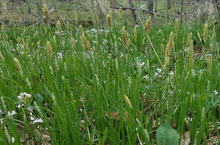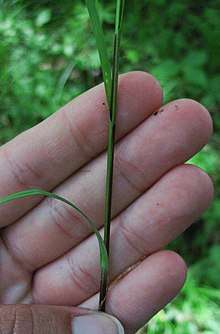Carex woodii
Carex woodii, known as pretty sedge, is a species of sedge native to North America.[2][3]
| Carex woodii | |
|---|---|
 | |
| Scientific classification | |
| Kingdom: | Plantae |
| Clade: | Tracheophytes |
| Clade: | Angiosperms |
| Clade: | Monocots |
| Clade: | Commelinids |
| Order: | Poales |
| Family: | Cyperaceae |
| Genus: | Carex |
| Subgenus: | Carex subg. Carex |
| Section: | Carex sect. Paniceae |
| Species: | C. woodii |
| Binomial name | |
| Carex woodii | |
Description
Carex woodii is a rhizomatous sedge, forming loose clumps to large vegetative colonies. The leaf sheathes are tinged with reddish-purple.[4] Compared to most other Carex across its range, it flowers and fruits earlier in the year. In Michigan it fruits by mid-May or earlier.[4]

Purple sheath of Carex woodii
Distribution and habitat
Carex woodii is native to the Midwestern and Eastern United States and Ontario.[3] It is found in both moist and dry woodlands.[3] It is considered a rare plant of concern in the Chicago region and Connecticut.[5]
gollark: Death Star flag I found in my photo library.
gollark: Klein flag!
gollark: Or elliptical.
gollark: Why not make the flag circular and annoy everyone at once?
gollark: What might work is dividing the central circle bit into some nice contrasting colors.
References
- "Carex woodii Dewey". ipni.org. International Plant Names Index. Retrieved 2018-09-25.
- "Carex woodii". Natural Resources Conservation Service PLANTS Database. USDA. Retrieved 2018-09-25.
- Flora of North America Editorial Committee, ed. (2002). "Carex woodii". Flora of North America North of Mexico (FNA). 23. New York and Oxford. Retrieved 2018-09-25 – via eFloras.org, Missouri Botanical Garden, St. Louis, MO & Harvard University Herbaria, Cambridge, MA.
- Reznicek, A. A.; Voss, E. G.; Walters, B. S., eds. (February 2011). "Carex woodii". Michigan Flora Online. University of Michigan Herbarium.
- "Monitored Species Gallery". plantsofconcern.org. Plants of Concern. 2 April 2017. Archived from the original on 2 April 2017. Retrieved 2017-04-02.
This article is issued from Wikipedia. The text is licensed under Creative Commons - Attribution - Sharealike. Additional terms may apply for the media files.